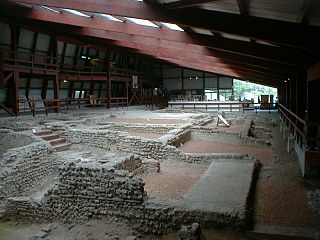
Lullingstone Roman Villa is a villa built during the Roman occupation of Britain, situated in Lullingstone near the village of Eynsford in Kent, south eastern England. The villa is located in the Darent Valley, along with six others, including those at Crofton, Crayford and Dartford. Constructed in the 1st century, perhaps around 80-90 CE, the house was repeatedly expanded and occupied until it was destroyed by fire in the 4th or 5th century. The villa was occupied over various periods within the Romano-British period, but after its destruction, it is only thought to have been reoccupied during the Medieval Times. The occupants were most likely wealthy Romans or native Britons who had adopted Roman customs.

Chedworth Roman Villa is located near Chedworth, Gloucestershire, England and is a scheduled monument. It is one of the largest and most elaborate Roman villas so far discovered in Britain and one with the latest occupation beyond the Roman period. The villa was built in phases from the early 2nd century to the 5th century, with the 4th-century construction transforming the building into an elite dwelling arranged around three sides of a courtyard. The 4th-century building included a heated and furnished west wing containing a dining-room (triclinium) with a fine mosaic floor, as well as two separate bathing suites: one for damp-heat and one for dry-heat.
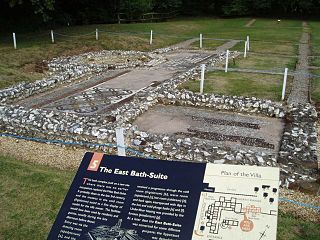
Rockbourne Roman Villa is a Roman courtyard villa excavated and put on public display in the village of Rockbourne in the English county of Hampshire. The villa was discovered in 1942 by a local farmer and excavated by A. T. Morley Hewitt over the next thirty years.
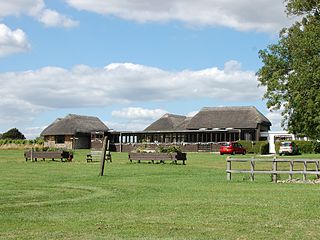
Bignor Roman Villa is a large Roman courtyard villa which has been excavated and put on public display on the Bignor estate in the English county of West Sussex. It is well known for its high quality mosaic floors, which are some of the most complete and intricate in the country.

Brading Roman Villa was a Roman courtyard villa which has been excavated and put on public display in Brading on the Isle of Wight.

Littlecote Roman Villa is an extensive and exceptional Roman villa, with associated religious complex, at Littlecote Park in Ramsbury, Wiltshire. It has been excavated and is on display to the public in the grounds of the estate.

The Low Ham Roman Villa was a Roman courtyard villa located near Low Ham in the civil parish of High Ham in the English county of Somerset. It is best known for the extraordinary figured mosaic depicting the story of Aeneas and Dido.
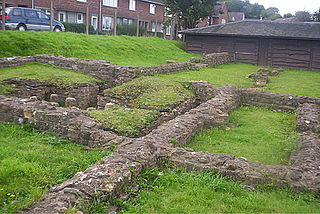
Kings Weston Roman Villa is a Roman villa in Lawrence Weston in the north-west of Bristol. The villa was discovered during the construction of the Lawrence Weston housing estate in 1947. Two distinct buildings were discovered. The Eastern building was fully excavated, the other lies mostly below Long Cross road. Finds from the site are now held in the Bristol City Museum and Art Gallery.
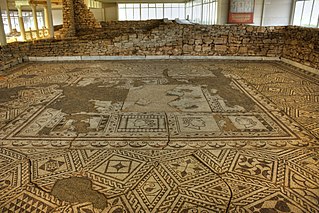
Villa Armira is a 1st-century suburban Roman villa in southeastern Bulgaria, located in the proximity of Ivaylovgrad, Haskovo Province. Discovered in 1964 during reservoir construction, it is a primary historical attraction to the Ivaylovgrad area. It is classified as a monument of culture of national importance.

The Domus Romana, stylized as the Domvs Romana, is a ruined Roman-era house located on the boundary between Mdina and Rabat, Malta. It was built in the 1st century BC as an aristocratic town house (domus) within the Roman city of Melite. In the 11th century, a Muslim cemetery was established on the remains of the domus.

North Leigh Roman Villa was a Roman courtyard villa in the Evenlode Valley about 0.5 miles (800 m) north of the hamlet of East End in North Leigh civil parish in Oxfordshire. It is a scheduled monument in the care of English Heritage and is open to the public.

Sparsholt Roman Villa was a Roman villa near the village of Sparsholt, Hampshire, England. It was constructed in phases from the 2nd to the 5th century, and then abandoned. It was excavated in 1965–72. Nothing is visible at the site today, but finds from the excavations are on display in Winchester City Museum, and one wing of the villa has been reconstructed at Butser Ancient Farm.

Folkestone Roman Villa, also referred to as the East Bay Site, is a villa built during the Roman Occupation of Britain, and is located in East Wear Bay near the port town of Folkestone, in Kent, England. The villa is situated on a cliff top overlooking the English Channel, with views of the French coast at Boulogne on a clear day. It is situated near the start of the North Downs Trackway, and the area has been inhabited for thousands of years, with archeological finds in the area and at the villa site dating back to the mesolithic and neolithic ages. The villa was built around A. D. 75, and was almost certainly built within the confines of a preexisting Iron Age settlement.
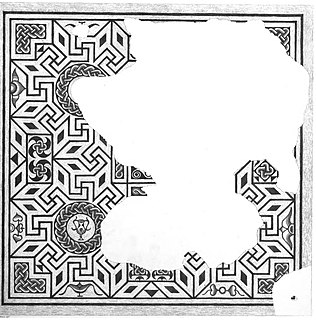
Boxmoor Roman Villa is a ruined Roman Villa at Boxmoor, Hemel Hempstead, Hertfordshire. The remains have been excavated, but they are now buried. The Roman villa was occupied from the first century AD up to the Fourth century.
At Eccles in Kent the remains of a huge Roman Villa with palatial dimensions were excavated between 1962 and 1976. In the second century AD, the villa was almost 112 m long. Over 135 different rooms have been identified throughout the various periods of construction and reconstruction. The villa was abandoned in the Fourth century and much of it was removed in the Thirteenth century for the construction of Aylesford Priory.

Winterton Roman villa is a Roman villa in Winterton, North Lincolnshire. It was discovered in 1747.

Rudston Roman villa is a Roman villa and scheduled monument near Rudston, East Riding of Yorkshire.
Brantingham Roman villa is a Roman villa and scheduled monument near Brantingham, East Riding of Yorkshire, England.
Wymondley Roman Villa is a ruined Roman villa near Hitchin, Hertfordshire, England. It is also known as Ninesprings Roman Villa. It is situated in the valley of the River Purwell in the parish of Great Wymondley. In Roman times, as now, the villa would have been above a wetland which is protected as the Purwell Ninesprings nature reserve.
Aiskew Roman villa is a Roman villa in Aiskew, North Yorkshire, England. It was identified by geophysical survey in July 2013 and partly excavated between November 2014 and February 2015.


















